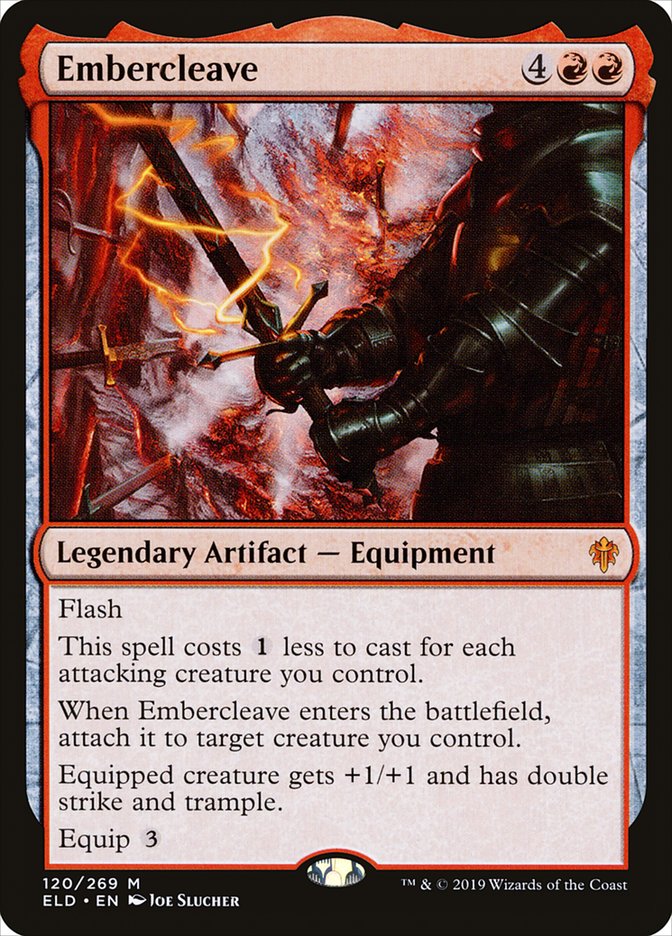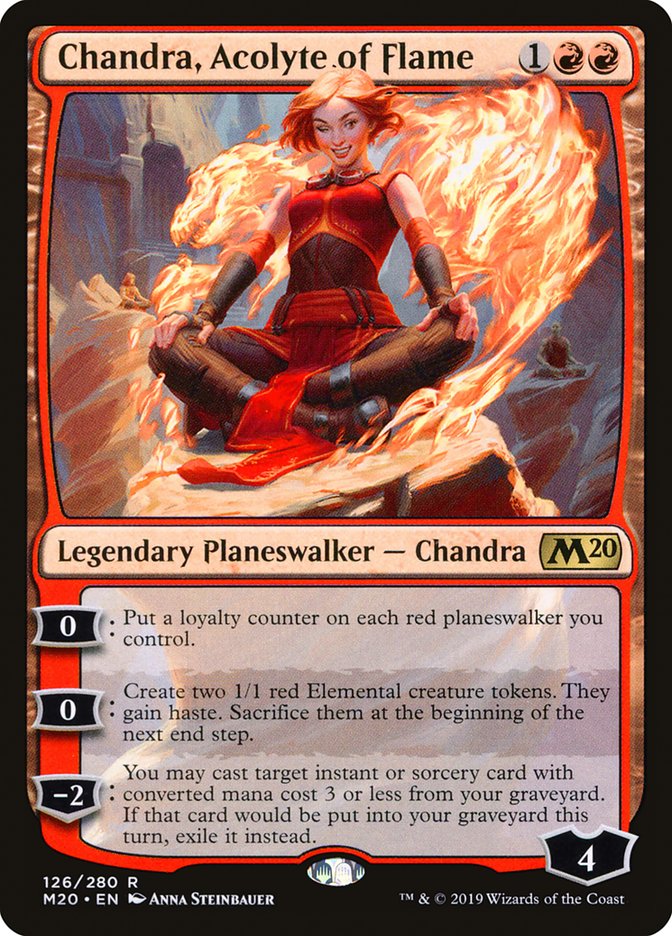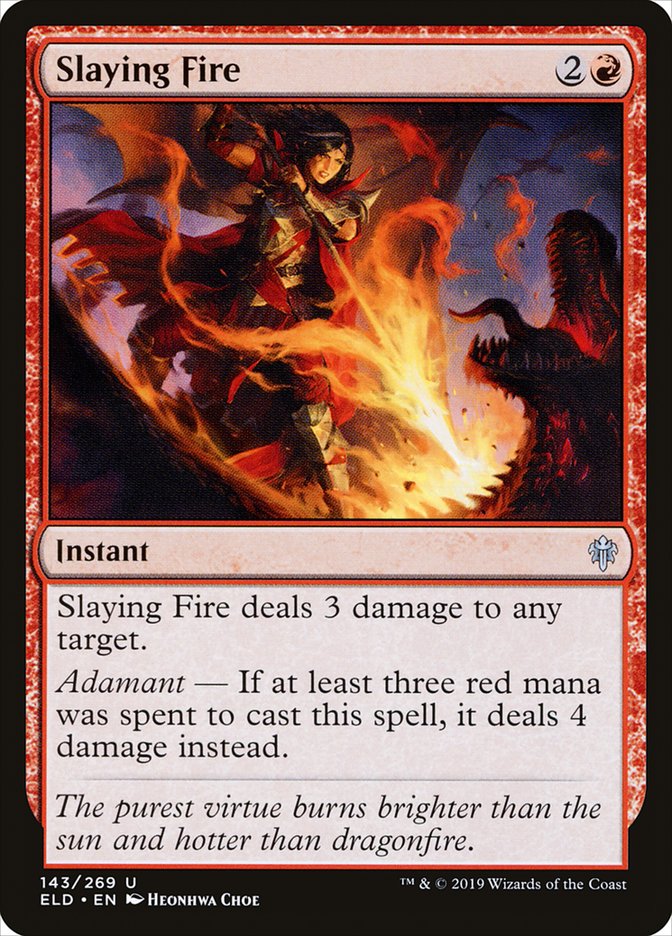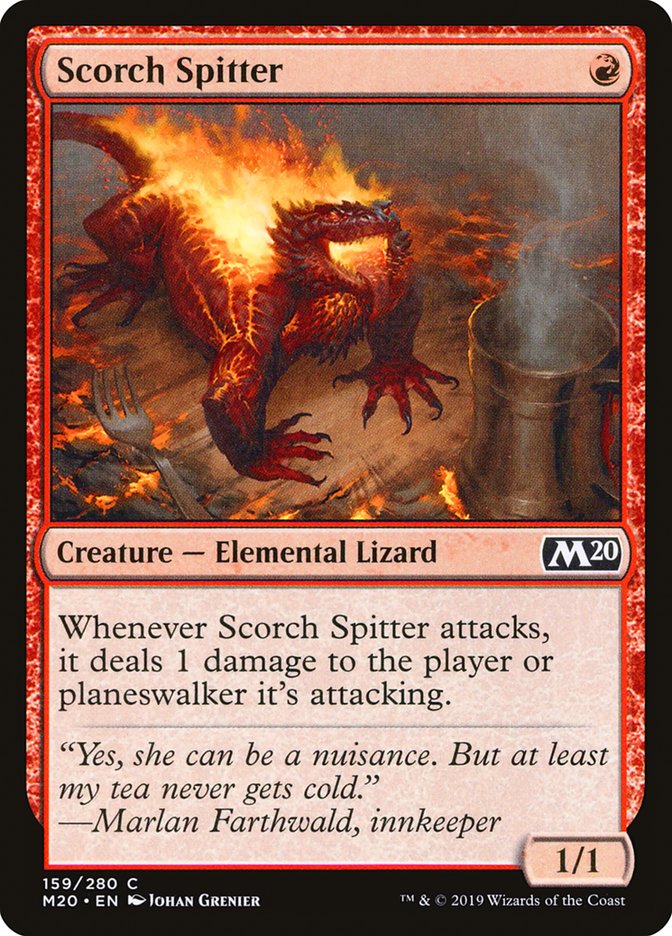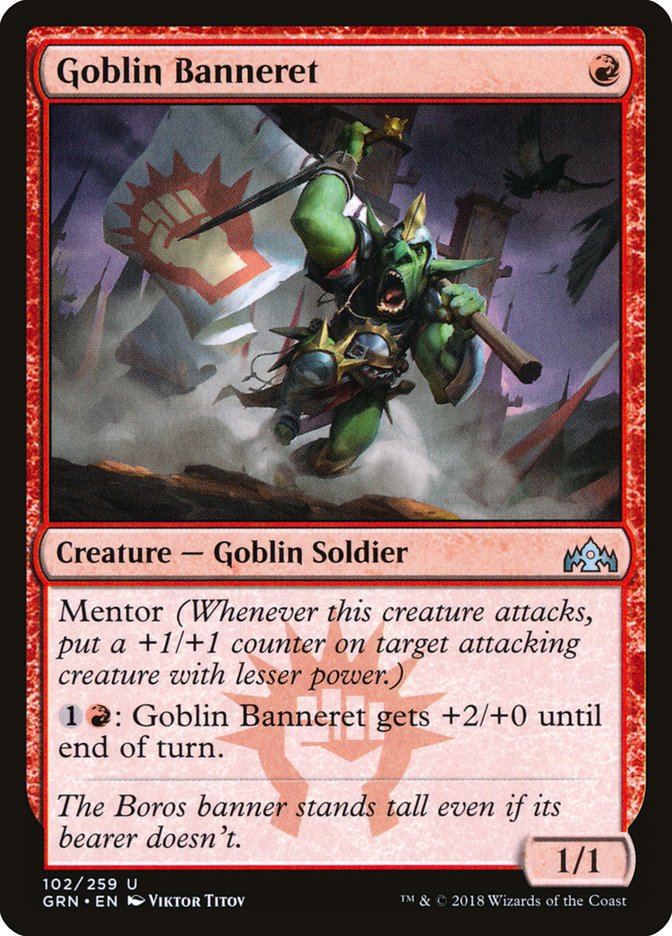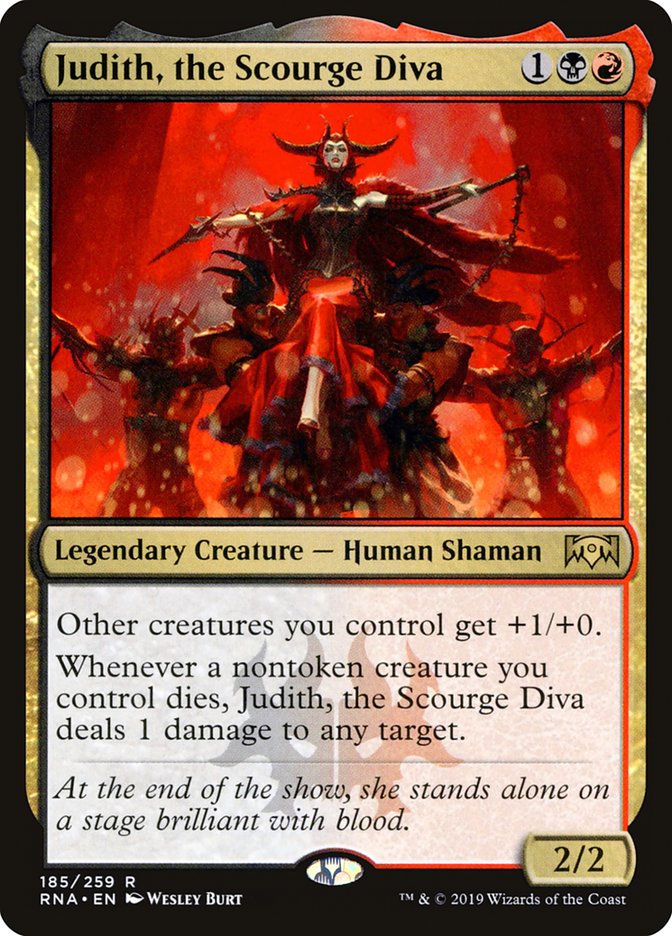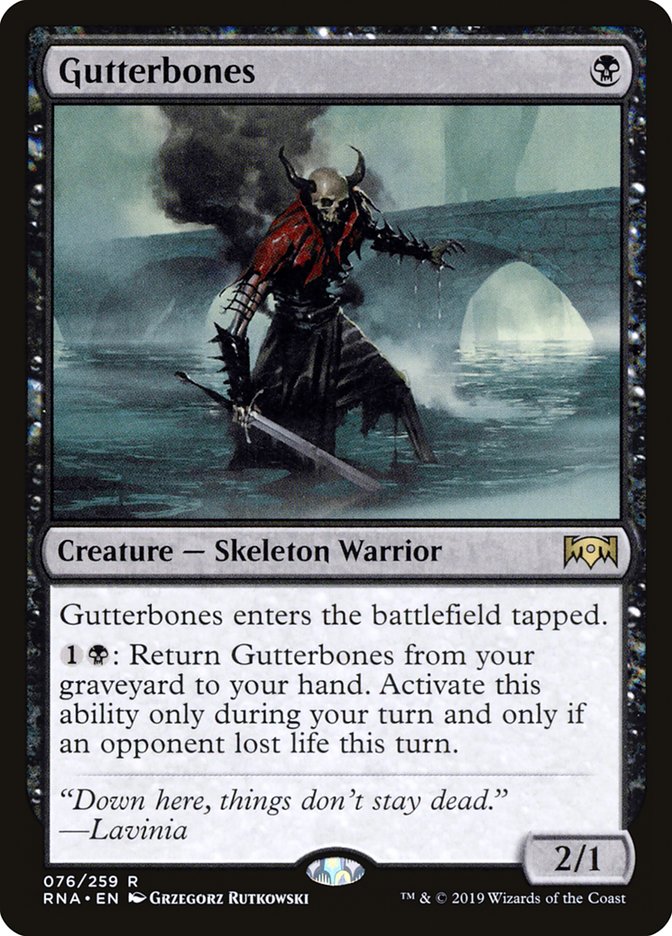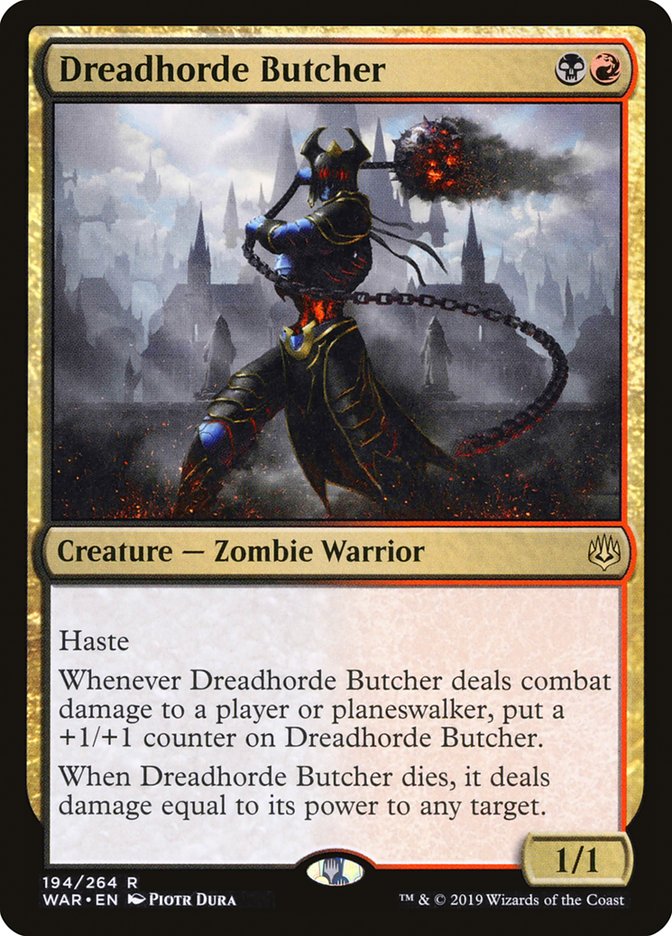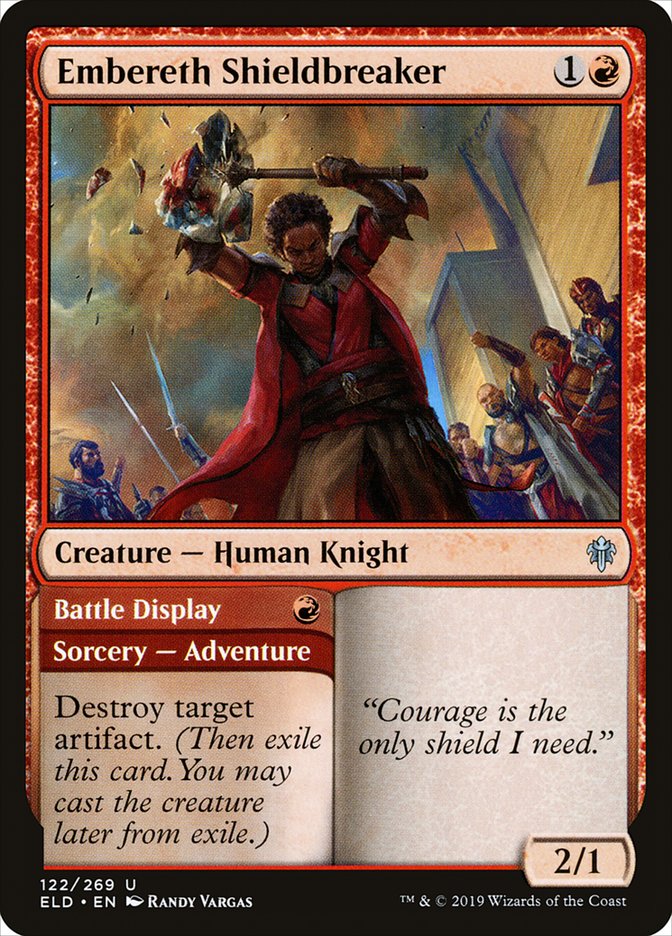I’m done trying to get fancy. To paraphrase the words of the great
philosopher Murtaugh: I’m too old for this stuff. I just want to play decks
that win, and when it comes to early season Standard, that means
starting with Mountains.
Preview season for Throne of Eldraine has just started, but
there’s already a red card that has caught my eye: Embercleave.
Cards like this, meaning splashy combat tricks, are often win more, but
this one is costed in a range that curves nicely. You can play three
one-drops on the opening two turns and then have this available as early as
Turn 3, or simply curve two-drop, three-drop and cast Embercleave on Turn
4. If you start your curve right away, the Turn 4 Embercleave happens
through a removal spell.
Second, unlike cards like Temur Battle Rage or Pride of the Conquerors,
Embercleave leaves behind a piece of powerful equipment. It can be used to
take out a blocker in combat while also turning one of your early creatures
into a powerful threat, drawing a removal spell and still sticking around
for your next creature to pick up. So, it’s a dual threat in that it can
function as a game-ending combat trick and late-game mana sink.
In the first mode, you’re getting a burst of damage that’s proportionate to
the power of the creature it’s attached to, but I can’t resist doing the
math to know exactly what we’re getting.
If the targeted creature starts at N power, the Embercleave will add one to
that, then double the result because of double strike. That yields a damage
output of 2N+2. Then we deduct the initial N, leaving a damage increase of
N+2. If we’re casting the card for two or three mana, attaching it to a
one- or two-power creature is enough immediate value, but anything more
than that and we’ll want a larger creature to make the mana investment
worthwhile.
That result reveals the inner tension of the card, which is the one thing
that concerns me. On the one hand you want to pair Embercleave with a deck
that creates a horde of small creatures to reduce its cost, while on the
other you want to pair it with larger creatures to maximize the power of
its effect. The fact that its effect does a solid job of producing damage
output even on smaller creatures tells me to favor the former in this
tension and make sure I’m casting it for cheap, but I’ll look to include
some cheap creatures that have the potential to grow larger in order to get
the best of both worlds some portion of the time.
The next step is to look for existing cards which synergize with
Embercleave, and the best example is Chandra, Acolyte of Flame.
Generating two haste bodies means Embercleave will be castable on Turn 4 if
you untap with Chandra and a fourth land in hand, regardless of how the
earlier turns played out. It won’t provide much immediate impact, but the
equip cost isn’t prohibitive and it will turn all your later creatures into
serious threats and in a scenario where you do have other creatures, the
Embercleave can end the game quickly.
Consider the rather pedestrian opening of Turn 2 Runaway Steam-Kin, Turn 3
Chandra, Acolyte of Flame. On Turn 4 you’re representing only four damage,
but Embercleave, castable for three mana, increases that to ten when
attached to the now 3/3 Runaway Steam-Kin. Here, Steam-Kin is a perfect
example of a creature that comes out early but represents a sizable body to
wield Embercleave later on.
Looking at potential lists, it’s best to start with the most basic:
Mono-Red Aggro is losing a lot of staples of the lists that have been
successful over the summer, like Ghitu Lavarunner, Viashino Pyromancer, and
Lightning Strike, but there’s still the incredibly powerful Experimental
Frenzy and enough solid creatures and burn spells to fill out a deck.
The decrease in burn makes me wary of the spectacle cards, so Skewer the
Critics leaves entirely while Light up the Stage has been trimmed down to
three. The land count must increase as a result, but with the added
late-game power from Chandra, Acolyte of Flame and Embercleave, I’m not
worried about flooding.
To help with the loss of Wizard’s Lightning and Lightning Strike, we have
the next great burn spell from Throne of Eldraine: Slaying Fire .
From Char to Flame Javelin, there’s a long history of paying three mana for
four damage to any target being the sweet spot for Standard, and we can
even flash it back for another round with Chandra, Acolyte of Flame. Expect
the spell to be a staple in red decks moving forward.
The rotation of Goblin Chainwhirler opens red decks to playing some utility
lands that produce colorless, but so far I don’t see the value in playing
those as they would weaken Slaying Fire. While Slaying Fire is still
castable with those lands, it’s much easier for them to coexist if a better
option comes along.
Legion Warboss joins Chandra as another three-drop that can generate
multiple bodies, and this one even pumps the tokens so we can get four
damage out of the first combat with Embercleave. With a relatively low
count of spells to target with Chandra’s -2, I favored Legion Warboss in
the split, but that could change if another good burn spell is previewed.
The major concern I have here is the quality of the one-drops. Scorch
Spitter and Goblin Banneret have their charms but are quite the downgrade
from Fanatical Firebrand and Ghitu Lavarunner. Scorch Spitter is a good
enabler for Light up the Stage, and without it I’d be skeptical of playing
the card at all, thus making Chandra, Acolyte of Flame significantly worse,
and Goblin Banneret is a great late-game target for Embercleave,
potentially turning into a two-card combo to steal games from ten or more
life.
That said, both are awkward in combat as base 1/1 creatures with no utility
outside of combat, making it harder to get ahead early. I’m not enthralled
with the idea of using two mana on an early turn to pump Goblin Banneret
just so I can attack, but this is what we have access to right now.
Hopefully Throne of Eldraine provides another option for the
one-drop slot, but if not, we may have to expand our horizons to another
color.
Looking at those colors, the best one-drops are clearly in black. Knight of
the Ebon Legion has been a staple of the Orzhov Vampires decks this summer,
but it’s more than just the best of its tribe – it’s definitely powerful
enough to stand on its own and like Goblin Banneret, can become a huge body
for Embercleave in the late game. Adding deathtouch makes it even better,
since you need only assign one damage to each blocker, letting more get
through via trample.
The second black one-drop, Gutterbones, is better than anything red offers,
so I’m ready to branch out and look at the Rakdos Aristocrats shell, a
fringe strategy that is mostly surviving rotation and could be an early
contender in Throne of Eldraine Standard.
Creatures (26)
- 1 Rix Maadi Reveler
- 3 Judith, the Scourge Diva
- 4 Gutterbones
- 4 Priest of Forgotten Gods
- 4 Dreadhorde Butcher
- 4 Mayhem Devil
- 2 God-Eternal Bontu
- 4 Knight of the Ebon Legion
Planeswalkers (3)
Lands (23)
Spells (8)
Sideboard

The trickiest thing here is the mana base, which is going to need another
dual land in order to work, but that’s one of the safest bets around.
Assuming that comes around to take the place of four of the basics, let’s
focus on the meat of the deck.
The mana is tricky because the one-drops skew you toward black, but Chandra
is a three-drop with two red mana in its casting cost. The synergy with
Priest of Forgotten Gods is powerful enough that I’m willing to stretch the
mana, but you could look toward Legion Warboss in that slot, or move away
from Priest entirely and focus on the aggressive elements, at which point
Spawn of Mayhem looks like a good option to fill that spot in the curve.
Embercleave certainly wants you to push the aggressive elements, which is
why I’ve included Judith, the Scourge Diva. With just her and Gutterbones,
you can cast Embercleave on Turn 4 for a ten-point attack. That one burst
of damage is enough to put your opponent into burn range, since between
Priest of Forgotten Gods, Dreadhorde Butcher, Mayhem Devil, Judith, and the
burn spells, this deck has a ton of reach.
The card I’m most excited to equip with Embercleave is Dreadhorde Butcher.
Double strike means you’ll get two triggers from each combat, quickly
growing the Zombie into a huge threat. Even an innocuous opening like
Butcher into Mayhem Devil allows for a Turn 4 Embercleave on a 3/3 Butcher
that then represents nine damage by itself that combat (since the third
+1/+1 counter is added before regular damage is dealt) while also growing
to 6/6. That’s a threat that demands an exile or bounce spell.
I also like that Dreadhorde Butcher is a haste threat for the late game
when Embercleave is lying around. Even as a 1/1, when immediately equipped
you have a creature that represents five immediate damage. The threat of
that can buy you extra time as your opponents are caught with the tough
decision of whether to play more conservatively to stop that topdeck or
close the game out earlier.
Adding another color greatly improves the sideboard over Mono-Red Aggro as
well, with better removal and staples like Duress. I still included a copy
of Embereth Shieldbreaker since I think it’s a potential sleeper in a set
where it looks like artifact synergies will be pushed with Food tokens and
several pushed equipment.
Equipment haven’t really shown up in Standard in recent years. Maybe
Wizards of the Coast is reticent to push them with mistakes like Cranial
Plating, Umezawa’s Jitte, and Stoneforge Mystic looming in our collective
memory, but I’ve always liked the card type as a way to press an early
advantage when cast and equipped on curve while also sticking around as a
mana sink to turn those early creatures into substantial threats.
Embercleave looks to be a powerful option for Throne of Eldraine
Standard that won’t be as dominant as the previously mentioned equipment
since curving out with it requires more than a single threat.
But in a format where combat and attrition are often the focus, having an
equipment that serves as one-part combat trick, one-part burn spell, and
one part mana sink is something to keep an eye on. And as more cards are
added to Standard, both from Throne of Eldraine and the following
sets, the curves in Standard will fill out and only make Embercleave more
powerful.


